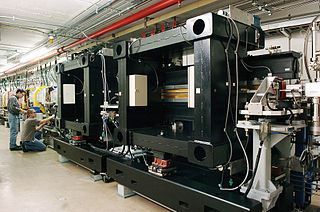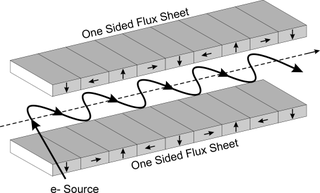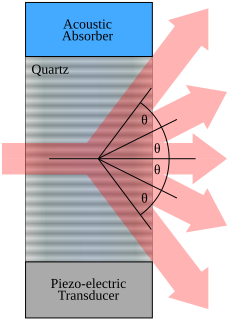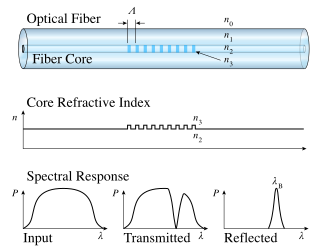
Diffraction is defined as the interference or bending of waves around the corners of an obstacle or through an aperture into the region of geometrical shadow of the obstacle/aperture. The diffracting object or aperture effectively becomes a secondary source of the propagating wave. Italian scientist Francesco Maria Grimaldi coined the word diffraction and was the first to record accurate observations of the phenomenon in 1660.

In physics, the wavelength is the spatial period of a periodic wave—the distance over which the wave's shape repeats. It is the distance between consecutive corresponding points of the same phase on the wave, such as two adjacent crests, troughs, or zero crossings, and is a characteristic of both traveling waves and standing waves, as well as other spatial wave patterns. The inverse of the wavelength is called the spatial frequency. Wavelength is commonly designated by the Greek letter lambda (λ). The term wavelength is also sometimes applied to modulated waves, and to the sinusoidal envelopes of modulated waves or waves formed by interference of several sinusoids.

Compton scattering, discovered by Arthur Holly Compton, is the scattering of a high frequency photon after an interaction with a charged particle, usually an electron. If it results in a decrease in energy of the photon, it is called the Compton effect. Part of the energy of the photon is transferred to the recoiling electron. Inverse Compton scattering occurs when a charged particle transfers part of its energy to a photon.

Thermal radiation is electromagnetic radiation generated by the thermal motion of particles in matter. Thermal radiation is generated when heat from the movement of charges in the material is converted to electromagnetic radiation. All matter with a temperature greater than absolute zero emits thermal radiation. At room temperature, most of the emission is in the infrared (IR) spectrum. Particle motion results in charge-acceleration or dipole oscillation which produces electromagnetic radiation.
In physics, Planck's law describes the spectral density of electromagnetic radiation emitted by a black body in thermal equilibrium at a given temperature T, when there is no net flow of matter or energy between the body and its environment.

A synchrotron light source is a source of electromagnetic radiation (EM) usually produced by a storage ring, for scientific and technical purposes. First observed in synchrotrons, synchrotron light is now produced by storage rings and other specialized particle accelerators, typically accelerating electrons. Once the high-energy electron beam has been generated, it is directed into auxiliary components such as bending magnets and insertion devices in storage rings and free electron lasers. These supply the strong magnetic fields perpendicular to the beam which are needed to convert high energy electrons into photons.
In physics and chemistry, Bragg's law, Wulff–Bragg's condition or Laue–Bragg interference, a special case of Laue diffraction, gives the angles for coherent scattering of waves from a crystal lattice. It encompasses the superposition of wave fronts scattered by lattice planes, leading to a strict relation between wavelength and scattering angle, or else to the wavevector transfer with respect to the crystal lattice. Such law had initially been formulated for X-rays upon crystals. However, It applies to all sorts of quantum beams, including neutron and electron waves at atomic distances, as well as visible light at artificial periodic microscale lattices.

An insertion device (ID) is a component in modern synchrotron light sources, so called because they are "inserted" into accelerator tracks. They are periodic magnetic structures that stimulate highly brilliant, forward-directed synchrotron radiation emission by forcing a stored charged particle beam to perform wiggles, or undulations, as they pass through the device. This motion is caused by the Lorentz force, and it is from this oscillatory motion that we get the names for the two classes of device, which are known as wigglers and undulators. As well as creating a brighter light, some insertion devices enable tuning of the light so that different frequencies can be generated for different applications.

Thomson scattering is the elastic scattering of electromagnetic radiation by a free charged particle, as described by classical electromagnetism. It is the low-energy limit of Compton scattering: the particle's kinetic energy and photon frequency do not change as a result of the scattering. This limit is valid as long as the photon energy is much smaller than the mass energy of the particle: , or equivalently, if the wavelength of the light is much greater than the Compton wavelength of the particle.

A free-electron laser (FEL) is a light source producing extremely brilliant and short pulses of radiation. An FEL functions and behaves in many ways like a laser, but instead of using stimulated emission from atomic or molecular excitations, it employs relativistic electrons as a gain medium. Radiation is generated as a bunch of electrons passes through a magnetic structure. In an FEL, this radiation is further amplified as the radiation re-interacts with the electron bunch such that the electrons start to emit coherently, thus allowing an exponential increase in overall radiation intensity.
The Smith–Purcell effect was the precursor of the free-electron laser (FEL). It was studied by Steve Smith, a graduate student under the guidance of Edward Purcell. In their experiment, they sent an energetic beam of electrons very closely parallel to the surface of a ruled optical diffraction grating, and thereby generated visible light. Smith showed there was negligible effect on the trajectory of the inducing electrons. Essentially, this is a form of Cherenkov radiation where the phase velocity of the light has been altered by the periodic grating. However, unlike Cherenkov radiation, there is no minimum or threshold particle velocity.

A wiggler is an insertion device in a synchrotron. It is a series of magnets designed to periodically laterally deflect ('wiggle') a beam of charged particles inside a storage ring of a synchrotron. These deflections create a change in acceleration which in turn produces emission of broad synchrotron radiation tangent to the curve, much like that of a bending magnet, but the intensity is higher due to the contribution of many magnetic dipoles in the wiggler. Furthermore, as the wavelength (λ) is decreased this means the frequency (ƒ) has increased. This increase of frequency is directly proportional to energy, hence, the wiggler creates a wavelength of light with a larger energy.

An acousto-optic modulator (AOM), also called a Bragg cell or an acousto-optic deflector (AOD), uses the acousto-optic effect to diffract and shift the frequency of light using sound waves. They are used in lasers for Q-switching, telecommunications for signal modulation, and in spectroscopy for frequency control. A piezoelectric transducer is attached to a material such as glass. An oscillating electric signal drives the transducer to vibrate, which creates sound waves in the material. These can be thought of as moving periodic planes of expansion and compression that change the index of refraction. Incoming light scatters off the resulting periodic index modulation and interference occurs similar to Bragg diffraction. The interaction can be thought of as a three-wave mixing process resulting in Sum-frequency generation or Difference-frequency generation between phonons and photons.

A fiber Bragg grating (FBG) is a type of distributed Bragg reflector constructed in a short segment of optical fiber that reflects particular wavelengths of light and transmits all others. This is achieved by creating a periodic variation in the refractive index of the fiber core, which generates a wavelength-specific dielectric mirror. Hence a fiber Bragg grating can be used as an inline optical fiber to block certain wavelengths, can be used for sensing applications, or it can be used as wavelength-specific reflector.
Radiation damping in accelerator physics is a way of reducing the beam emittance of a high-velocity charged particle beam by synchrotron radiation.

Electron scattering occurs when electrons are deviated from their original trajectory. This is due to the electrostatic forces within matter interaction or, if an external magnetic field is present, the electron may be deflected by the Lorentz force. This scattering typically happens with solids such as metals, semiconductors and insulators; and is a limiting factor in integrated circuits and transistors.
The National Synchrotron Light Source (NSLS) at Brookhaven National Laboratory (BNL) in Upton, New York was a national user research facility funded by the U.S. Department of Energy (DOE). Built from 1978 through 1984, and officially shut down on September 30, 2014, the NSLS was considered a second-generation synchrotron.
Interference lithography is a technique for patterning regular arrays of fine features, without the use of complex optical systems or photomasks.

The Mainz Microtron, abbreviated MAMI, is a microtron which provides a continuous wave, high intensity, polarized electron beam with an energy up to 1.6 GeV. MAMI is the core of an experimental facility for particle, nuclear and X-ray radiation physics at the Johannes Gutenberg University in Mainz (Germany). It is one of the largest campus-based accelerator facilities for basic research in Europe. The experiments at MAMI are performed by about 200 physicists of many countries organized in international collaborations.

X-ray emission spectroscopy (XES) is a form of X-ray spectroscopy in which the X-ray line spectra are measured with a spectral resolution sufficient to analyze the impact of the chemical environment on the X-ray line energy and on branching ratios. This is done by exciting electrons out of their shell and then watching the emitted photons of the recombinating electrons.



















